Past the salt? The future of water desalination
Although a vital element in many of the world’s water systems, desalination has never quite reached its absolute full potential. A combination of high costs, inefficient processes and environmental concerns have served to somewhat restrict its growth and divide opinions. But that could be about to change. Higher levels of investment and pioneering technological advances could finally see desalination establish itself as the lynchpin in the global fight against water scarcity.
By Fady Jameel, Deputy President and Vice Chairman, Abdul Latif Jameel
The eye-watering reality of water scarcity
Water scarcity is a humanitarian, economic, and ecological crisis. The UN Food and Agriculture Organization (FAO) recognizes it as one of the most urgent challenges for our society’s sustainable development.[1] According to a recent report from UNICEF and the World Health Organization (WHO), 1 in 3 people in the world do not have access to safe drinking water.[2]
The World Resources Institute reveals that 17 countries—home to one-quarter of the world’s population—face “extremely high” levels of baseline water stress.[3] Twelve of these countries are in the Middle East and North Africa, where the arid climate is compounded by ever-increasing agricultural, industrial, and domestic water use.[4]
Water scarcity is truly a global problem. Massive, rapidly growing demand puts the US, China, and India in the danger zone. In 2018, Cape Town was just 90 days away from turning off the taps.[5] Even regions with a relative abundance of water can contribute to the problem.
 A study carried out as part of the EU’s IMPREX project[6] (IMproving PRedictions and management of hydrological EXtremes), found that 38 percent of the EU’s effective water consumption occurs beyond its borders in the production of goods and services – often by regions directly affected by water scarcity.[7]
A study carried out as part of the EU’s IMPREX project[6] (IMproving PRedictions and management of hydrological EXtremes), found that 38 percent of the EU’s effective water consumption occurs beyond its borders in the production of goods and services – often by regions directly affected by water scarcity.[7]
The supply of fresh water has been steadily decreasing while demand has been steadily rising. In the 20th Century, the world’s population quadrupled – but water use increased six-fold.[8]
By 2050, supply could decline up to 25 percent in many of the world’s water basins.[9] Within the next 30 years, World Bank experts believe that water scarcity could cost some regions up to 6 percent of GDP and lead to mass migration and conflict.[10] In contrast, these risks could be neutralized with better policy decisions, with some regions standing to improve their growth rates by up to 6 percent with better water resource management.
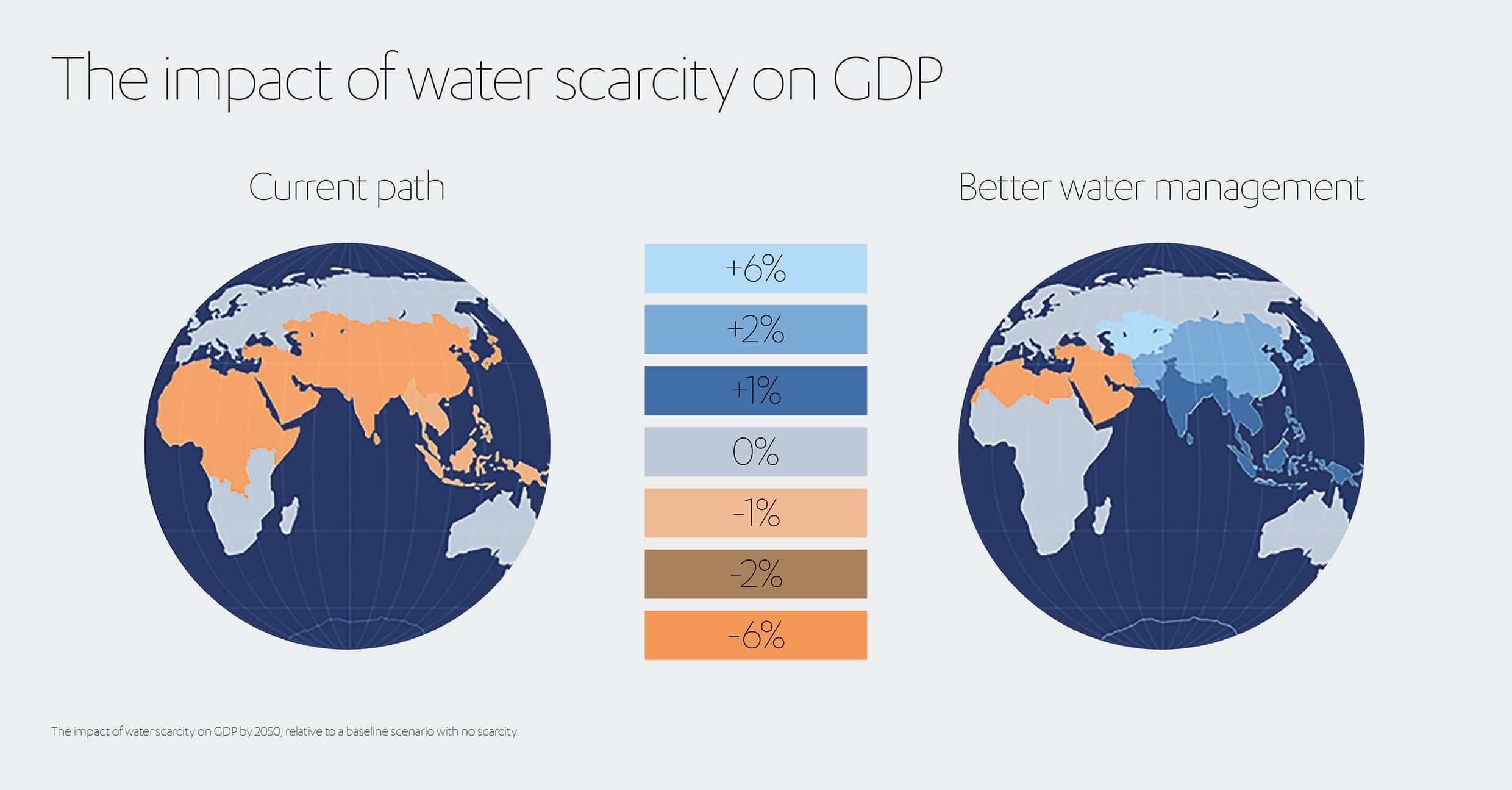
 Water scarcity impacts several of the 17 United Nations (UN) Sustainable Development Goals (SDGs), including Clean Water and Sanitation (SDG 6), Climate Action (SDG 13), Affordable and Clean Energy (SDG 7), and Zero Hunger (SDG 2).[11] Climate change, in particular, is a significant cause for concern.
Water scarcity impacts several of the 17 United Nations (UN) Sustainable Development Goals (SDGs), including Clean Water and Sanitation (SDG 6), Climate Action (SDG 13), Affordable and Clean Energy (SDG 7), and Zero Hunger (SDG 2).[11] Climate change, in particular, is a significant cause for concern.
The FAO estimates that “for each one degree of global warming, 7 percent of the global population will see a decrease of 20 percent or more in renewable water resources”.[12]
The answer is obvious. We need more water. Luckily, we are surrounded by it.
Water, water everywhere
There is a slight problem, however. Around 71 percent of the planet is covered in water, yet only 1 percent is fit for human consumption. 2 percent is frozen, and the rest lies in the oceans, lakes, groundwater, etc. (along with vast quantities of sodium, various other minerals, pollutants, and all marine life).
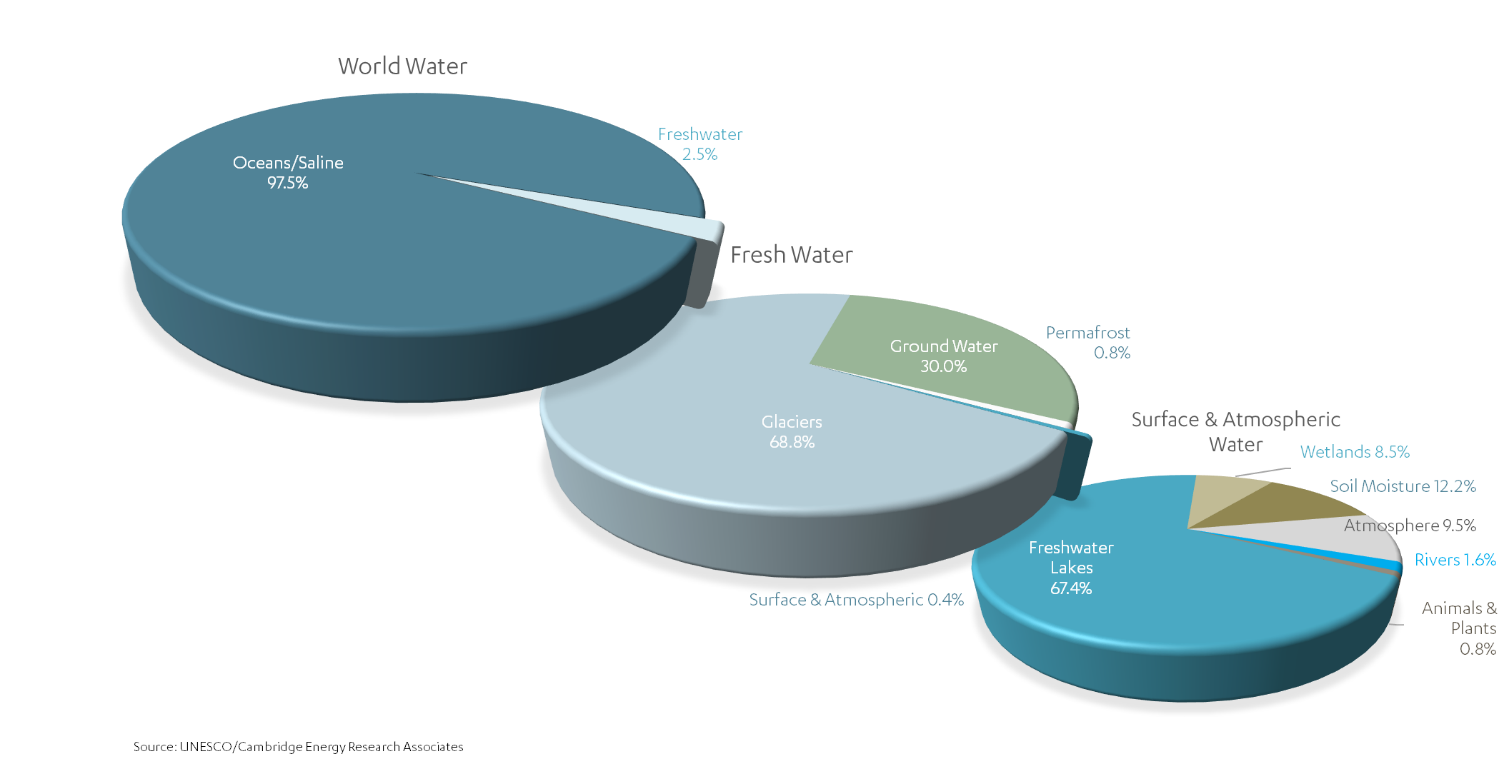
Turning water from the ocean into water that is fit for human use, let alone direct consumption, is not as easy a process as one might think, due largely to the large amount of salt and other impurities in sea water.
Water desalination is the process of extracting salt from seawater to create fresh water, which can be converted into ultrapure water for drinking or potable water for industry and agriculture.
Thermal desalination and membrane desalination are the two most popular methods.
Thermal desalination uses heat to evaporate water and separate it from the salt. In membrane desalination, reverse osmosis (RO) exploits the natural process of osmosis, transferring water through semi-permeable membranes to remove salt and other impurities. Many desalination plants also pretreat water to improve efficiency.
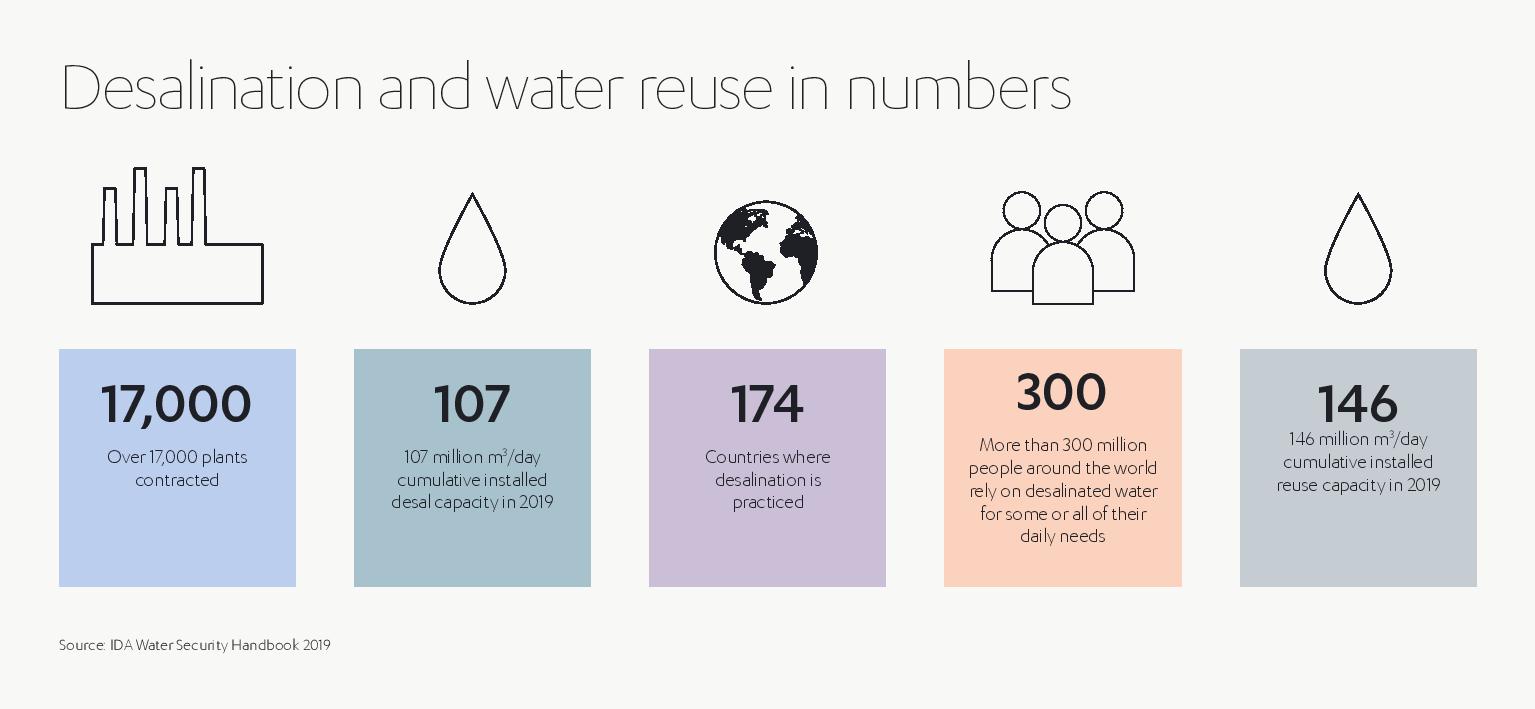
There are more than 17,000 desalination plants across 174 countries, producing 107 million cubic meters of desalinated water every day.[13] Many countries simply could not function without it. The Middle East accounts for just under half of total capacity, while Asia, China, the United States, and South America are scaling up their desalination capacity fast.
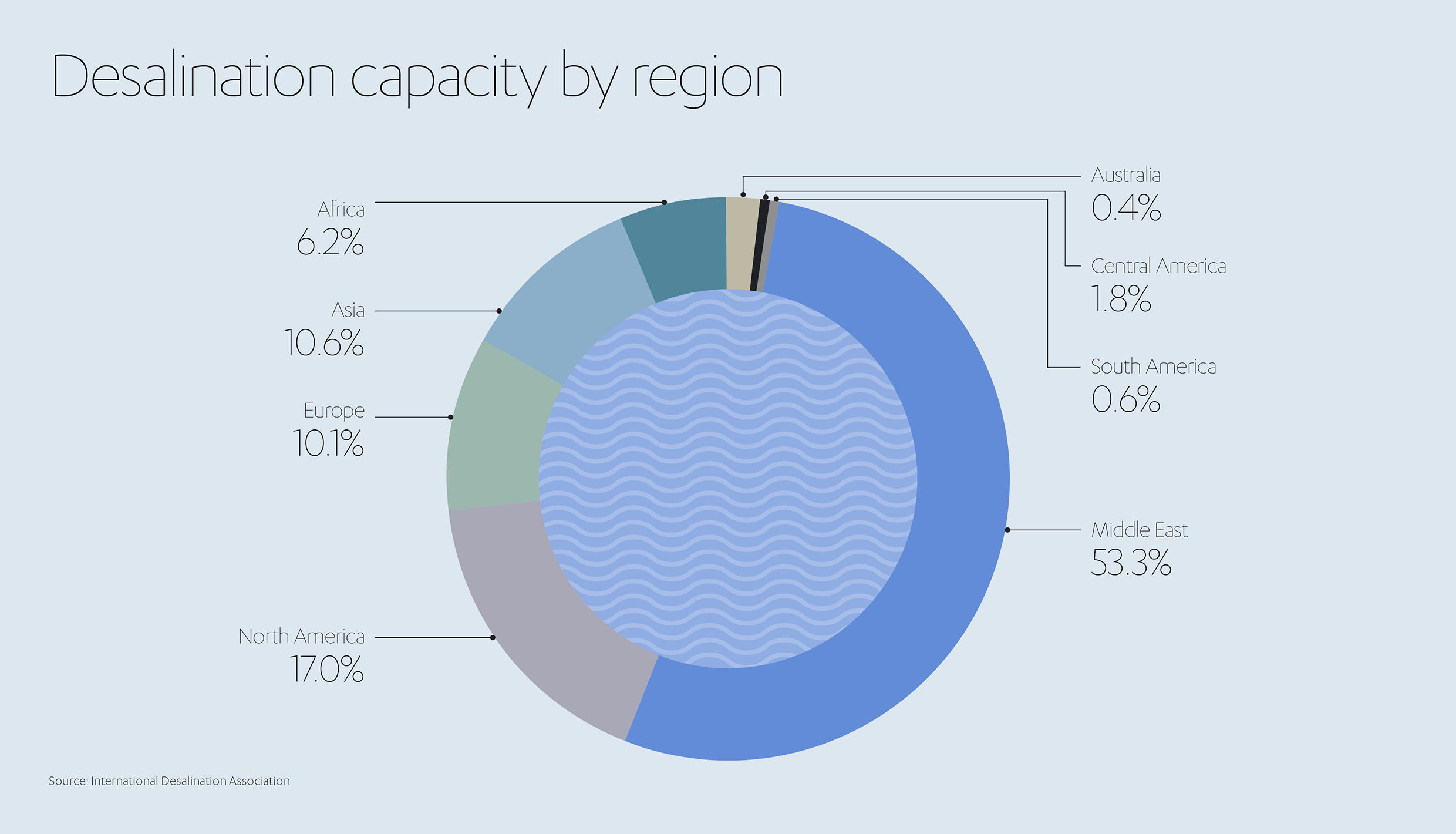
Saudi Arabia is extending its already significant desalination infrastructure. And at a personal level, I am proud to say that Abdul Latif Jameel is starting to play an increasingly significant role in this through Almar Water Solutions.
 Almar Water Solutions is a specialist provider of technical capabilities for water infrastructure development, including design, financing and operation. It has proven to be the ideal complement sister company to Fotowatio Renewable Ventures, (FRV) our flagship renewable energy business both a part of Abdul Latif Jameel Energy.
Almar Water Solutions is a specialist provider of technical capabilities for water infrastructure development, including design, financing and operation. It has proven to be the ideal complement sister company to Fotowatio Renewable Ventures, (FRV) our flagship renewable energy business both a part of Abdul Latif Jameel Energy.
In January 2019, Almar Water Solutions was awarded the contract in Saudi Arabia to develop Al Shuqaiq 3 IWP, one of the world’s largest reverse osmosis desalination plants.
Situated near the Red Sea city of Al Shuqaiq, a US$ 600 million investment will fund the development of a plant covering the size of 34 soccer fields. When it is completed in 2021, it will deliver 450,000m3 of clean water each day on a 25-year build-own-operate scheme with SWPC. More than 1.8 million people will receive fresh water from the site, while 700 jobs will be created.
News of our involvement came less than eight weeks after we were awarded the contract to produce Kenya’s first large-scale desalination plant. Once operational, the site will deliver 100,000m3 of drinking water to more than one million people in Mombasa, on Kenya’s coastline, where a severe water crisis has caused interruptions in supply for several years.
Take desalination with a pinch of salt
An effectively limitless raw supply makes water desalination a potentially key process resource to reduce water dependency and bring security and prosperity to some of the world’s poorest nations. Unfortunately, it can also be expensive, energy-intensive.
The average reverse osmosis plant burns through up to 13-kilowatt hours per thousand gallons processed.[14] Most of that energy, today, comes from fossil fuels. By 2020, global CO2 emissions from carbon-powered desalination plants could reach 218 million tons.[15] Obviously, emitting more carbon dioxide to solve a problem itself caused in a large part by climate change is clearly unsustainable and self-defeating.
Ironically, desalination is often most uneconomical in those areas that need it the most. In addition to significant energy costs, water is heavy and expensive to transport relative to its value. This means desalination plants are typically located on the coast and near the point of use, serving relatively affluent industrial, commercial, or domestic demand[16]. Leaving more deprived, inland areas relatively more ‘high and dry’.
According to the United Nations University Institute for Water, Environment and Health, for affordable and environmentally friendly desalination systems to be rolled out in low-income and lower-middle-income countries, technological innovations are necessary, along with innovative financial mechanisms to support the sustainability of such schemes.[17]
Environmental concerns
Concerns have also been raised about the main by-product of desalination: the highly salt-concentrated wastewater called brine. Some critics claim that brine depletes the oxygen levels in seawater and can be harmful to marine life, so it therefore needs diffusing over large areas to minimize the impact. A recent report from the UN University found that desalination plants discharge 50 percent more brine than previously thought, enough to put Florida 30cm beneath water each year.[18]
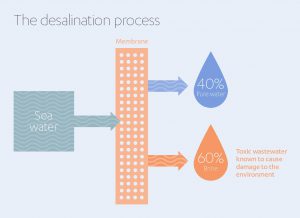 The International Desalination Association (IDA), however, downplays these concerns: “Long-term experience worldwide indicates that discharges from seawater desalination plants are environmentally safe and do not result in change of aquatic flora and fauna.”[19]
The International Desalination Association (IDA), however, downplays these concerns: “Long-term experience worldwide indicates that discharges from seawater desalination plants are environmentally safe and do not result in change of aquatic flora and fauna.”[19]
Many experts agree that brine is not toxic. It is simply the same salts that were in the sea originally, and which are subsequently returned to the sea after membrane filtration. In terms of needing to diffuse the brine over a large area to dilute it, they point to the fact that all the water output from desalination plants – the desalinated water as well as the brine – ultimately finds its way back to the sea as part of the normal water cycle, so the dilution level is naturally maintained. In addition, rainwater adds further to this dilution, ensuring the oceans maintain a natural level of salt concentration.
Thirsty for innovation
Despite the challenges, I strongly believe there are many reasons to be positive. Recent advances in technology and R&D suggest that desalination is on the verge of a breakthrough that could transform global water systems.
Continuous innovation since the 1970s has already reduced the energy consumption of reverse osmosis by a factor of 10, with costs expected to decline by up to two-thirds over the next two decades.[20] Extensive research into pre-treatment, nano-technology filtering, and electrochemical methods promises to make desalination more efficient. Much of the research focuses on improving the efficiency of the membranes used in reverse osmosis and other membrane desalination processes.
Nanostructured membranes have been shown to deliver 20 percent productivity gains. Using densely packed carbon nanotubes in reverse osmosis membranes could reduce desalination costs to the level of conventional water treatment technologies within a decade.[21]
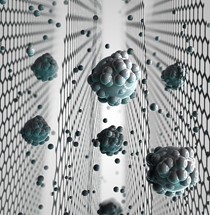
Scientists at The University of Manchester recently developed a graphene sieve that converts seawater into drinking water, which holds significant potential if it can be scaled up.[22] Commenting in the peer-reviewed journal Nature Nanotechnology, Professor Rahul Reveendran Nair, at Manchester University, said: “Realization of scalable membranes with uniform pore size down to atomic scale is a significant step forward and will open new possibilities for improving the efficiency of desalination technology.”[23]
Another British company, G20, is using graphene oxide to improve the effectiveness of existing polymer-based membrane filters.[24]
Learning from nature
Nature offers plenty of chemistry lessons, too.
Some of the most exciting research is attempting to mimic the ingenious water transport solutions devised by evolution. Biomimetic membranes with aquaporin structures modeled on microorganisms are in the early stages of research but could provide a breakthrough in low-energy desalination.[25]
Forward osmosis, the process by which plants absorb water from the soil, is already used in industrial wastewater treatment and might also be feasible for desalination. Unlike reverse osmosis, which uses pressure, forward osmosis is a low energy process. ‘Switchable salts’ pull pure water from seawater and deposit it on the other side of a membrane. Forcing heated air through the briny additive then converts it into gas, which can be collected and reused in a highly energy-efficient loop.[26]
Researchers are repaying the favor to plants. Water scarcity means agriculture is becoming increasingly dependent on desalination. Still, the primary technology used, reverse osmosis, wastes a lot of water and removes useful nutrients that must be added back through fertilizer. But leading-edge research is developing potential new solutions here, too.
“Intelligent Selective Electrodialysis (ISED) selectively removes from the water the ions that plants don’t like – monovalent (single charge) ions like sodium and chloride – while keeping useful nutrients like calcium and magnesium,” says Kishor Govind Nayar, a doctoral student at the Abdul Latif Jameel Water and Food Security Lab (J-WAFS) at MIT. “We believe this solution could save up to 25 percent in water consumption and 30 percent in fertilizer use, compared to reverse osmosis,” adds Kishor.
One of the main problems with reverse osmosis is the fouling of the membrane with salts and biologically active material (biofouling).[27] Chemical pre-treatment of the incoming water is costly, time-consuming, and only partially effective. There is an increasing drive towards green desalination, which reduces the chemicals used in desalination using advanced pre-treatment design and operation. Professor Xuanhe Zhao, another J-WAFS researcher, and his team are developing a vibration-based membrane cleaning technology with the potential to improve the efficiency and working life of the membrane and reduce the costs of reverse osmosis.

All these efficiency-boosting technologies will make it easier to ramp up production.
There is also a swathe of innovations that focus on making the desalination process itself ‘cleaner’.
So-called ‘zero-liquid discharge’[28] (ZLD) systems reduce the generation of brine, for example, by treating wastewater through recycling and then recovery and reuse for industrial purpose.
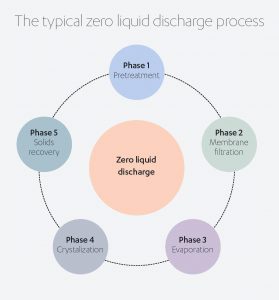 Although currently a costly process, ZLD paves the way for economic benefits by recovering salts and other potentially useful minerals from the discharge.
Although currently a costly process, ZLD paves the way for economic benefits by recovering salts and other potentially useful minerals from the discharge.
The sea has the biggest reserves of lithium in the world, as well as other valuable minerals such calcium, sodium, magnesium and potassium. The hope is that, in future, technologies will be available to isolate these minerals and produce desalinated water as a by-product for industrial, domestic and agricultural use, helping to solve the problem of scarcity.
A recent report from UN University called for more investment to develop cost-effective methods of extracting these substances, which are vital to numerous industries.[29]
The Desalination Technology Research Institute of the Saline Water Conversion Corporation (SWCC) in Saudi Arabia, one of the biggest users of desalination technology, recently patented a dual brine concentration device that generates two high-mineral content streams from seawater.[30] Calcium from brine could also be used for post-treatment of desalinated water, reducing dependence on commercially supplied compounds.[31]
The future is sunny
While these emerging technologies are encouraging, the future potable depends on taking action now.
To be truly sustainable and cost effective, water technology needs increased investment in efficiency-boosting best practices and, crucially, sustainable energy.
 The International Desalination Association’s (IDA) Global Clean Water Desalination Alliance set a goal for 20 percent of new plants to be powered by renewables between 2020-2025.[32] The alliance brings together key stakeholders from the energy and desalination industries, water utilities, governments, financing institutions, academia, and R&D “with the goal to reduce CO2 emissions from existing water desalination plants and to scale up the use of clean desalination technologies through coordinated actions.”[33]
The International Desalination Association’s (IDA) Global Clean Water Desalination Alliance set a goal for 20 percent of new plants to be powered by renewables between 2020-2025.[32] The alliance brings together key stakeholders from the energy and desalination industries, water utilities, governments, financing institutions, academia, and R&D “with the goal to reduce CO2 emissions from existing water desalination plants and to scale up the use of clean desalination technologies through coordinated actions.”[33]
Forward-looking governments are already mobilizing. Saudi Arabia has brought forward its Vision 2030 target of generating 9.5GW of renewable energy to 2023. In Western Australia, all new desalination plants are already required to use renewable energy. The Perth Seawater Desalination Plant (SWRO), the first of its kind in Australia, is powered by electricity generated by a wind farm.
Designing for energy efficiency
There are three main ways to increase plant efficiency: colocation, cogeneration, and hybrid technology.
Co-located plants use coolant water from a nearby power station as feedwater. Because this water has already been warmed, the process uses less energy. The byproduct water is then added to the power plant’s cooling water outflow, which dilutes it before returning to the ocean. For example, the Tampa Bay Seawater RO Desalination Facility in Florida uses up to 444 million gallons of warm seawater from the cooling system at Tampa Electric’s (TECO) Big Bend Power Station.[34]
Cogeneration plants use waste steam from a power plant as an additional energy source to reduce their use of fossil fuels.
Hybrid plants combine different treatment methods to optimize plant performance, for instance, reverse osmosis for brackish water and ion exchange[35] for water with high organic content, as used in the Cape Hatteras desalination plant in North Carolina.[36]
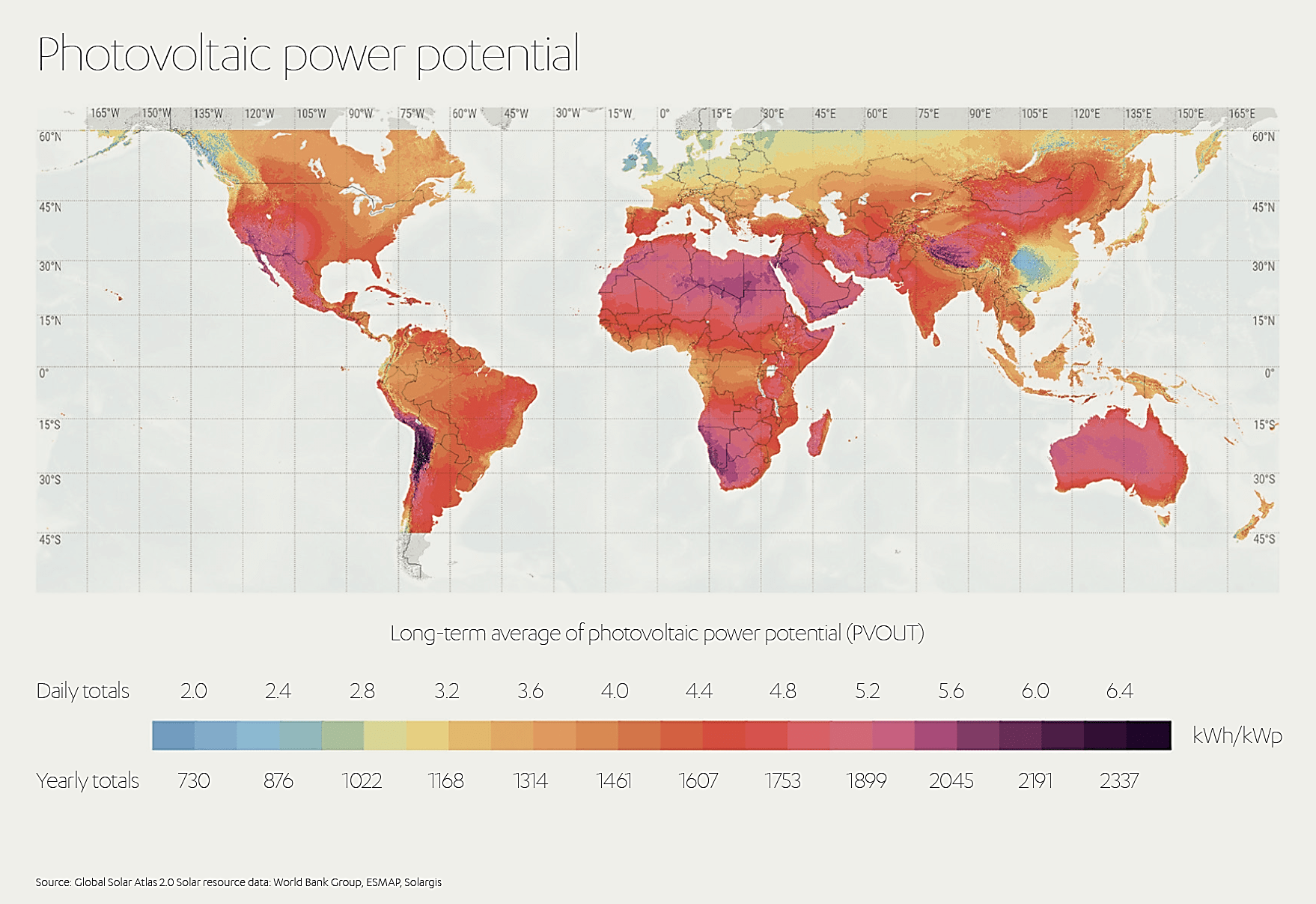 Unleashing the potential of solar energy is especially important because, of course, many of the countries with the least water have the most sun.Efficient design is essential, but the real opportunity lies in replacing fossil fuels with renewable energy sources. Hydro, geothermal, and nuclear are mature technologies that can provide the high levels of consistent energy that desalination demands. Until recently, solar and wind energy were seen as too expensive to be viable for powering desalination plants, but that is now changing – and fast.
Unleashing the potential of solar energy is especially important because, of course, many of the countries with the least water have the most sun.Efficient design is essential, but the real opportunity lies in replacing fossil fuels with renewable energy sources. Hydro, geothermal, and nuclear are mature technologies that can provide the high levels of consistent energy that desalination demands. Until recently, solar and wind energy were seen as too expensive to be viable for powering desalination plants, but that is now changing – and fast.
Fortunately, technological advances are making the prospect of solar a reality.
A passive solar-powered desalination system developed by researchers at J-WAFS and in China could produce more than 1.5 gallons of fresh drinking water per hour from one square meter of solar panel area. The highly efficient system uses heat released from each stage to power the next stage. “Such systems could potentially serve off-grid arid coastal areas to provide an efficient, low-cost water source,” according to MIT.[37]
Many renewable-powered developments are backed by organizations helping communities who cannot afford them. The non-profit GivePower is supplying battery-driven solar-powered desalination systems to impoverished communities around the world.[38] One such desalination plant in Kenya has been providing up to 19,800 gallons of drinking water each day for two years, enough for around 25,000 people.[39]
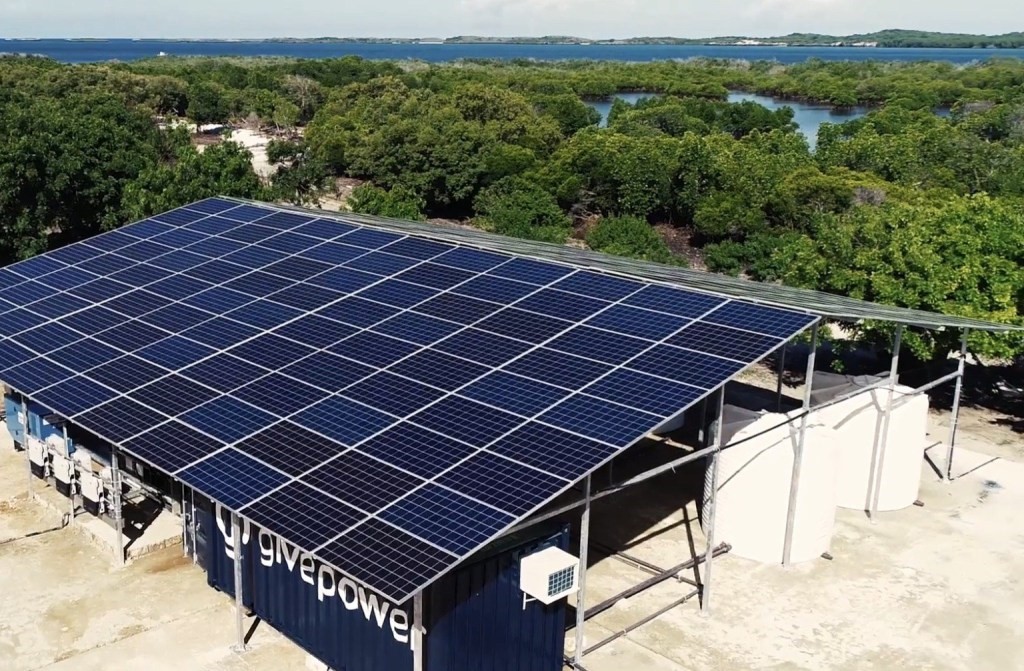
Renewable energy provides particular benefits to low and middle-income countries. Switching desalination to solar power provides carbon-neutral power while freeing up oil for export, thus boosting the economy. It also means that desalination can be closer to towns and cities, rather than power stations, therefore lowering the cost of distribution and the risk of waste.
Water for all
Water desalination is vital now and will only become more critical as the pressure on water supplies continues to grow. Political stability, economic growth—and the continued survival of millions—depend on it.
Though meeting the challenge of water scarcity will require coordinated efforts to reduce consumption and develop more efficient wastewater recycling, water desalination will remain an essential part of our toolkit to ensure the future for our planet.
The water crisis is everyone’s responsibility, and there is every reason to believe we can solve this challenge together.
Political and personal responsibility will drive the agenda. Investment and innovation in renewable energy will provide reliable desalination to those who need it most, while reducing our dependence on fossil fuels and mitigating the impact of climate change. And emerging technology will herald breakthroughs in productivity, efficiency, and waste management—helping to secure a sustainable future for all.
[1] http://www.fao.org/about/en/
[2] https://www.who.int/news-room/detail/18-06-2019-1-in-3-people-globally-do-not-have-access-to-safe-drinking-water-unicef-who
[3] https://www.wri.org/news/2019/07/release-updated-global-water-risk-atlas-reveals-top-water-stressed-countries-and-states
[4] https://www.wri.org/blog/2019/08/17-countries-home-one-quarter-world-population-face-extremely-high-water-stress
[5] https://www.weforum.org/agenda/2019/08/cape-town-was-90-days-away-from-running-out-of-water-heres-how-it-averted-the-crisis/
[7] Dependencies of Europe’s economy on other parts of the world in terms of water resources
[8] https://www.mckinsey.com/business-functions/sustainability/our-insights/water-a-human-and-business-priority
[9] https://www.mckinsey.com/business-functions/sustainability/our-insights/climate-risk-and-response-physical-hazards-and-socioeconomic-impacts
[10] https://www.worldbank.org/en/topic/water/publication/high-and-dry-climate-change-water-and-the-economy
[12] http://www.fao.org/zhc/detail-events/en/c/880881/
[13] https://idadesal.org/wp-content/uploads/2019/04/World-Bank-Report-2019.pdf
[14] https://www.nationalgeographic.com/environment/2019/01/desalination-plants-produce-twice-as-much-waste-brine-as-thought/
[15] Energy Efficient Desalination, International Water Summit, 15-18 January 2018
[16] https://idadesal.org/wp-content/uploads/2019/04/World-Bank-Report-2019.pdf
[17] https://www.unenvironment.org/news-and-stories/story/towards-sustainable-desalination
[18] https://unu.edu/media-relations/releases/un-warns-of-rising-levels-of-toxic-brine.html
[19] https://idadesal.org/wp-content/uploads/2019/10/EEC-White-Paper-10-13.pdf
[20] https://idadesal.org/wp-content/uploads/2019/04/World-Bank-Report-2019.pdf
[21] https://idadesal.org/wp-content/uploads/2019/04/World-Bank-Report-2019.pdf
[22] https://www.manchester.ac.uk/discover/news/graphene-sieve-turns-seawater-into-drinking-water/
[23] https://www.nature.com/articles/nmat5025
[24] https://www.theguardian.com/world/2019/apr/10/desalination-world-clean-water-crisis
[25] https://www.ncbi.nlm.nih.gov/pmc/articles/PMC6161077/
[26] https://www.herox.com/blog/162-the-challenge-of-desalination
[27] Treating A Moving Target: Harmful Algal Blooms
[28] https://www.sciencedirect.com/topics/engineering/zero-liquid-discharge
[29] https://unu.edu/media-relations/releases/un-warns-of-rising-levels-of-toxic-brine.html
[30] https://saudigazette.com.sa/article/571985
[31] https://idadesal.org/wp-content/uploads/2019/10/EEC-White-Paper-10-13.pdf
[33] http://climateinitiativesplatform.org/index.php/Global_Clean_Water_Desalination_Alliance_(GCWDA)
[34] https://www.waterworld.com/home/article/14071194/desalination-opportunities-and-challenges
[35] #:~:text=Ion%20exchange%20is%20the%20most,combined%20with%20selective%20ion%20exchange.
[36] https://www.waterworld.com/home/article/14071194/desalination-opportunities-and-challenges
[37] http://news.mit.edu/2020/passive-solar-powered-water-desalination-0207
[38] https://givepower.org/projects-2/
[39] https://bigthink.com/technology-innovation/solar-power-desalination





 1x
1x

 Added to press kit
Added to press kit


